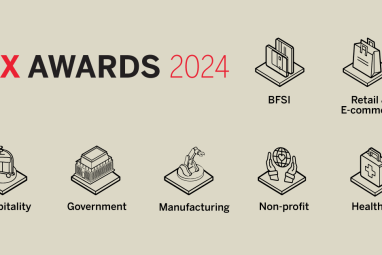What Brands Can Do to Power Next-level Customer Experience in the Middle East
CX leaders and innovators at the Customer Centricity Summit 2024 discussed emerging trends, roles, and strategies shaping CX in the Middle East.
News
- Gulf Nations Fast-Track AI Ambitions, UAE Leads Regional Readiness, says BCG Report
- AI Professionals form a Redefined Workforce. But Systemic Roadblocks Persist, Survey Finds
- AI-Driven Scams Surge as Microsoft Blocks $4 Billion in Fraud Attempts
- Identity-based Attacks Account for 60% of Leading Cyber Threats, Report Finds
- CERN and Pure Storage Partner to Power Data Innovation in High-Energy Physics
- CyberArk Launches New Machine Identity Security Platform to Protect Cloud Workloads

[Image source: Krishna Prasad/MITSMR Middle East]
Customer experiences (CX) have evolved in the last few years as our expectations have accelerated. Speed, relevance, and personalized experiences are now the baseline of customer expectations across digital and physical retail. To match customer preferences, brands invest in the R&D of good CX that drives sales, customer happiness, and brand loyalty.
Customer obsession is heralded as a virtue in business, and CX is the most important element to a company’s success because it boosts resilience and prepares it for future growth.
To uncover and dissect the Middle East’s CX journey, MIT SMR Middle East‘s inaugural Customer Centricity Summit in Riyadh on November 13 brought together impactful CX leaders and innovators to showcase their findings and expertise, how they are maximizing customer convenience and making a lasting mark on the CX industry.
Redefining the “Customer First” Gold Standard
Regardless of sector, product, or outreach, businesses worldwide abide by the industry standard of putting the “customer first.” However, in his opening remarks at the summit, Oliver West, the Head of Customer Experience at VML, challenged this norm, stressing that the survival of any organization, from healthcare to public services, ranks far higher than the CX. “The reality is its business first. It doesn’t matter how good or how well you treat your customer. If you don’t focus on business, then the business won’t last.”
In the post-pandemic CX landscape, customer focus has seen greater success across industries than the “customer first” rule of thumb. A global survey by Bain & Company found that as many as 80% of surveyed companies “believe they deliver a superior customer experience,” and only 8% of customers agree.
West highlighted this perception gap to deliver a renewed approach to CX in the region. As set by industry leaders such as Amazon and Uber, CX in the digital age must be “fast, easy, and transparent,” he said.
Sarah Al Yousef, the General Manager of Digital and Customer Experience at Go Telecom, resonated with West’s insights. In the opening panel discussion, Understanding Modern Customers Habits and Experiences, Al Yousef advised brands “to be closer to the customer.” With the resurgence of social media-driven e-commerce, she said, “customers want more personalized experiences in real time” that lend them a sense of authenticity and empathy. The quicker prospective and existing customers connect with a brand, the easier loyalty is cemented in a highly volatile digital marketplace, she added.
Tying Technology to Value
In the case of booming industries such as real estate in the Middle East, Sara Altaweel, the Marketing Director at Sakani, the National Housing Service Company (NHC), said that brands must prioritize transparency throughout their marketing campaigns and platform UIs to drive sustained engagement.
Adam Szucs, Senior Solution Advisor CX, EMEA South at SAP MRSIS, shared the vendor perspective on the evolving nature of value in the region. According to Szucs, up to 24% of customers demand personalization “as soon as they give their data to a brand.” Customers prefer curated experiences to the “pre-existing one-off personalized discounts or vouchers” brands use to mine customer data.
A new wave of awareness and information has dawned on the Middle East, propelled by the region’s digitally adept population. Szucs alluded to a common practice followed by most brands to create a customer database. “Giving a mobile number to anybody when buying something is almost natural in Saudi Arabia. But if somebody’s asking for your email address, you are double-checking, and you have this question in mind: What will this email address be used for? The more questions they ask about you, the more they want to know why.” This underscores the importance of transparency when curating a “customer first” experience.
The demand for value has skyrocketed since the pandemic. Customers demand value the moment they click on or step into an experience. Celine Gergess, the Marketing Director at Cenomi Retail, referenced the industrywide evolution in marketing as a direct result of this behavioral shift. “Most teams had to be really intrigued to cope with this change. New roles emerged, and others became obsolete,” Gergess said. For marketing campaigns to remain relevant and create impact, agility is paramount. As the digital marketplace transitions from the e-commerce era to the age of AI, “teams are restructuring with a focus on agility and flexibility,” Gergess added.
Despite the Middle East’s technological readiness, industry experts echoed the need for variety in personalization. Altaweel stressed the importance of catering to Gen Z and Baby Boomers by abandoning the “one size fits all” notion and adopting a hybrid take that blends online and offline experiences.
Christian Jomaa of AppsFlyer touched on the untapped potential for mobile apps in the Middle East’s CX landscape. Building and sustaining customer loyalty has moved from advertisements and billboards to our fingertips. Jomaa utilized Al Shaya’s Aura app as a case study to cement brand loyalty in the age of apps. “The Middle East is the strongest region when it comes to loyalty programs. [Aura] facilitates its value chain through a points system at stores or restaurants listed on the app,” said Jomaa.
Digital Storytelling to Build Customer Loyalty
The way customers demand, transact, and consume commodities tells brands a story. The story of a sector, an economy, or a generation. In the past, marketing campaigns weaved nuanced narratives that spoke to crowds. But in the digital age, customers demand stories tailored to their preferences and conditions.
Aamir Allibhoy, the Chief Marketing Officer at Tim Hortons, spoke about the impact of messaging and narratives in driving sales across industries. Sana Kothari, co-host of the Byron Cooke Show with Sana K. on MBC Loud FM, spoke about holding an evolved audience with a fleeting attention span. She shared the 8.7 second journey of capturing an audience’s attention and satisfying the carving for relatable content on air.
Beyond our screens, the physical spaces we inhibit also act as channels for storytelling and viable spaces for shared experiences. Donya Abdulhadi, the Executive Director of Marketing and Communications at the Diriyah Biennale Foundation and the JAX District, part of the Ministry of Culture, shared how to harness the power of recognized, local spaces in starting conversations across the region, with a keen focus on Saudi Arabia.
The launch of the Islamic Arts Biennale at the Hajj terminal in Jeddah was the region’s first experiential art installation. “The Hajj terminal is a place of transition that brings people together. We’ve repurposed that into a permanent space for culture.” Abdulhadi added “Under those canopies, you see these contemporary art installations, public programs, masterclasses and workshops, and people just hanging out.”
According to Abdulhadi, “brands must not be afraid” to succeed in hyper-digital ecosystems like Saudi Arabia. Decades ago, brands were free to “fool the customer with [generic] stories. But today’s customers are more aware than ever.”
Today, customers want to consume authentic content across the board. Kothari echoed the evolution of storytelling with a focus on radio. To derive value from an experience, it must resonate and align with the values of its target audience. In Saudi Arabia, “family is extremely important,” said Kothari. “People don’t value the quickest delivery or two-hour shipments here]. Instead, they value the speed at which they’re going to get a product and how much time it saves them to spend with their family.” Allibhoy believes in establishing resonance through authenticity. To illustrate this concept, he explained the subtle art of product placement in upcoming mediums such as podcasts, “When two people have a conversation, it’s quite natural and normal to have coffee or for coffee to spark it. So, I guess the question and the answer comes down to the platform, the content, and the personality you’re associating your brand with,” Allibhoy added.
Where AI and Marketing Intersect
Alannah Higgins, Senior Account Executive at Braze, explored the crucial gap in the CX puzzle where emerging technologies like AI and marketing strategies must meet to create a lingering CX.
Using Careem’s super app as an example, Higgins demonstrated how Braze leverages omnichannel online channels to push messaging to its furthest limits and wider audiences.
The gamification strategy crafted by Braze allows marketers to seamlessly instill new habits in customers using push notifications, WhatsApp messaging, or email. Higgins also showcased Braze’s competitive AI assistant, which allows the firm to seamlessly toggle between “creating an email that has a high call to action and will help launch a new product” and optimizing the most suitable messaging channels to sustain customer loyalty.
Hassan El-Tahan, Vice President of Growth at Gathern, echoed push notifications’ power and untapped potential in the grand CX scheme. Marketers are re-routing their messages to overcome fundamental behavioural roadblocks such as diminishing attention spans and inbox fatigue. By observing performance marketing data, platforms like Gathern eliminate strategies with the lowest engagement across channels or tailor them to run on specific channels for the best results.
What the Next Generation of CX Looks Like
Kate Artsybysheva, Hospitality Director at the Saudi Motorsport Company, shared the power in diverse perspectives. According to Artsybysheva, a successful CX template considers input from all stakeholders. Arthur Zhuravsky, Director of Customer Experience at Tabby, echoed a similar sentiment. “If you are successful in proving the connection between customer experience and money, statistically, you will win the attention and trust of other stakeholders with their own KPIs.”
In a dynamic digital marketplace where everyone owns CX, it is often hard to align board members, decide on the best message, and deliver it. In such cases, Zhuravsky advises brands to “start with the culture and buy from the sea level up.” In the case of Tabby, Zhuravsky pioneered a “CX squad” to ensure precision in messaging across departments. “At Tabby, we’re not searching for customer satisfaction; we’re looking for ways [to spark] customer delight.”.
The customer centricity landscape will continue to be loaded with microtrends and data to back or discredit them. In dynamic times like this, brands and marketers have proven that drowning out the digital chatter and observing patterns offline can lead to better CX.
The Customer Centricity Summit & Awards 2024 was held on November 13, 2024, at the Crowne Plaza Riyadh – RDC, with Gold Sponsors: AppsFlyer, Braze, HEMOdata, and Zoho, and Silver Sponsor: Emarsys.





